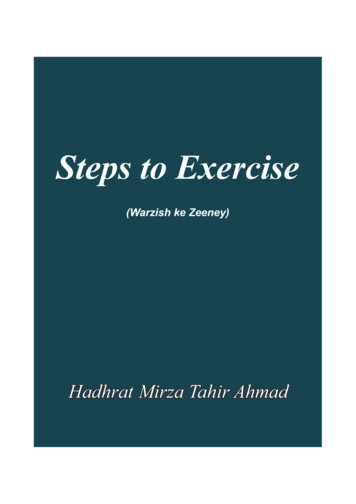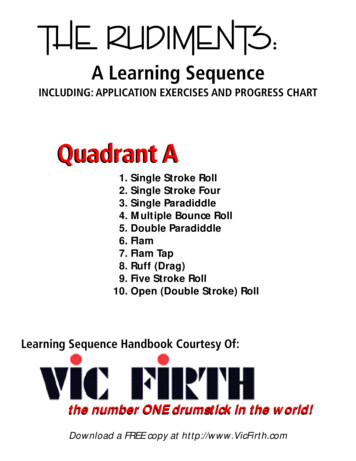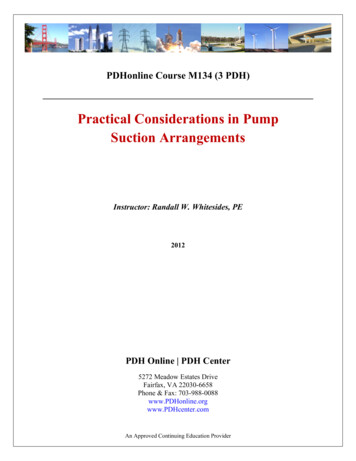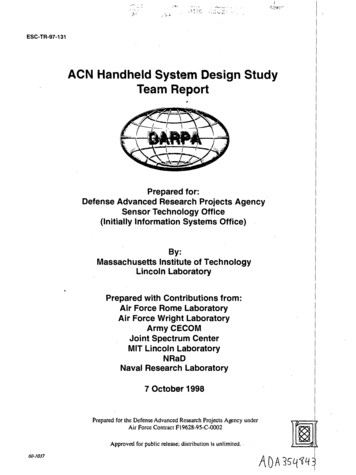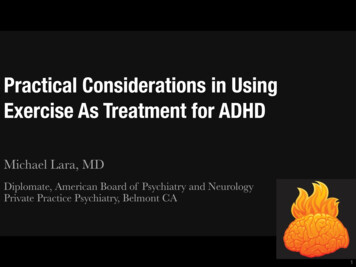
Transcription
Practical Considerations in UsingExercise As Treatment for ADHDMichael Lara, MDDiplomate, American Board of Psychiatry and NeurologyPrivate Practice Psychiatry, Belmont CA1
2
3
3
3
3
Evolutionary MilestonesHumans evolved primarily as hunter gatherer species‣ 84,000 Generations From emergence of Homo species 2.4 million years ago, humans have survivedprimarily as hunter gatherer species‣ 350 Generations Ago Agricultural Revolution‣ 75 Generations Ago Industrial Revolution‣ 2 Generations Digital Age4
Typical Activities of Hunter-GathererPhysical activities of our paleolithic ancestors have correlates inmodern day forms of exercise5
Typical Activities of Hunter-GathererPhysical activities of our paleolithic ancestors have correlates inmodern day forms of exercise‣ Slow Cardio: 5-10 miles/day of low intensity walking Hunter gatherers cover 5-15 miles per day5
Typical Activities of Hunter-GathererPhysical activities of our paleolithic ancestors have correlates inmodern day forms of exercise‣ Slow Cardio: 5-10 miles/day of low intensity walking Hunter gatherers cover 5-15 miles per day‣ Resistance Training: Lifting, Throwing, and CarryingObjects Encompass functional movements such as pushing, pulling,sprinting, and jumping5
Typical Activities of Hunter-GathererPhysical activities of our paleolithic ancestors have correlates inmodern day forms of exercise‣ Slow Cardio: 5-10 miles/day of low intensity walking Hunter gatherers cover 5-15 miles per day‣ Resistance Training: Lifting, Throwing, and CarryingObjects Encompass functional movements such as pushing, pulling,sprinting, and jumping‣ Interval Training: Periodic bursts of high-intensity activity Brief bouts of sprinting alternating with walking or joggingin pursuit of prey5
Nature Deficit DisorderDiminished use of senses and attentionaldifficulties due to alienation from nature6
Nature Deficit DisorderDiminished use of senses and attentionaldifficulties due to alienation from nature6
Exercising to Improve ADHD SymptomsCharacteristics of an ideal exercise program for ADHDADHD SymptomsADHD ExerciseProgramOften has difficulty organizing tasksand activitiesStructured workouts that are partof a comprehensive programVarietyOften avoids, dislikes, or isreluctant to engage in tasks thatrequire sustained mental effortIncorporate constantly variedfunctional movements: squatting,pushing, pulling, sprinting,throwingNoveltyOften has difficulty sustainingattention in tasks or play activitiesLearning and acquisition of newskills in natural environmentsIs often easily distracted byextraneous stimuliExercise outdoors with active andpassive attentionStructureMonitoring7
Exercise Programs for ADHDPrograms that include cross-training outdoors8
Exercise Programs for ADHDPrograms that include cross-training outdoorsCrossfit“constantly varied, high-intensity functionalmovements with goal of increasing work capacityacross broad time and modal domains”crossfit.com8
Exercise Programs for ADHDPrograms that include cross-training outdoorsCrossfitFit by Nature“constantly varied, high-intensity functionalmovements with goal of increasing work capacityacross broad time and modal domains”crossfit.comOutdoor fitness program incorporating crosstraining and body weight exercises acrossdifferent terrains. Adventx.com8
Exercise Programs for ADHDPrograms that include cross-training outdoorsCrossfitFit by NaturePrimalFitness“constantly varied, high-intensity functionalmovements with goal of increasing work capacityacross broad time and modal domains”crossfit.comOutdoor fitness program incorporating crosstraining and body weight exercises acrossdifferent terrains. Adventx.comMoving frequently at a slow pace, lift heavy things,and sprint. marksdailyapple.com8
Primal Fitness“The Primal Blueprint” by Mark SissonSprint“All Out” efforts once every 7-10 days,for 10 minutesLift HeavyThingsMove Frequently ata Slow PaceBrief, intense sessions of full-bodyfunctional movements for up to 30minutes 1-3x/weekWalk, hike or jog at55-75% maximum heartrate for 2-5 hours/week9
Move Frequently at a Slow PaceLeisurely walks in nature at least five times/week‣ Exercise in greenenvironments reduces stressand improves focus‣ Leisurely walks improve fatmetabolism and insulinsensitivity‣ Engages passive attention10
ADD and the Cerebellum‣ Cerebellum is responsible forcoordination, precision andaccurate timing of movement‣ Contains 50-80% of totalneurons in brain‣ Cerebellum is dysfunctional inADD‣ Moving to rhythm or cadencemay improve symptoms ofADD‣ Cadence beats: podrunner.com11
Lift Heavy ThingsPushing, pulling, squatting, and throwing‣ Heavy resistance trainingincreases growth hormone(GH) and testosterone‣ Low levels of GH/IGF-1associated with cognitivedecline‣ Testosterone may improvesome domains of cognitivefunction12
13
Body-Weight Resistance TrainingThe Big 5 of Body Weight Resistance Training12345Upper BodyPush-ups, pull-ups, chin-ups, rowsLower BodySquats, lunges, jumpsCoreSit-ups, hanging leg-raises, planksBackGood Mornings, bridgingTotal BodySquats, dead lifts, bear crawls, burpees14
15
16
17
SprintRunning at maximal intensity for no more than 30 seconds‣ Exercise intensity correlateswith rise of catecholaminesand brain-derivedneurotrophic factor (BDNF)‣ High-intensity interval training(HIIT) may increase glycogenstorage in astrocytes cells‣ Carb loading for the brain18
High-Intensity Interval TrainingHIIT involves “all out” efforts with fixed work:rest ratios19
High-Intensity Interval TrainingHIIT involves “all out” efforts with fixed work:rest ratios30:30Total time: 10 min30 seconds of work30 seconds of rest19
High-Intensity Interval TrainingHIIT involves “all out” efforts with fixed work:rest ratios15:45Total time: 10 min30:30Total time: 10 min15 seconds ofwork30 seconds of work45 seconds of rest30 seconds of rest19
High-Intensity Interval TrainingHIIT involves “all out” efforts with fixed work:rest ratiosTabata20:10Total time: 4 min15:45Total time: 10 min30:30Total time: 10 min20 seconds of work10 secondsof rest15 seconds ofwork30 seconds of work45 seconds of rest30 seconds of rest19
Exercise, Nutrition and The BrainFood For Thought:How Nutrients Affect the Brainwww.ibpceu/catalog20
Exercise, Nutrition and The BrainFood For Thought:How Nutrients Affect the BrainExercisewww.ibpceu/catalog20
Exercise, Nutrition and The BrainFood For Thought:How Nutrients Affect the BrainExerciseNutritionwww.ibpceu/catalog20
Intermittent FastingNutritional strategy that alternates brief periods of fasting withnon-fasting21
Intermittent FastingNutritional strategy that alternates brief periods of fasting withnon-fasting‣ Fasting raises catecholamine levels Norepinephrine and dopamine levels rise in the first 8 hoursof fasting21
Intermittent FastingNutritional strategy that alternates brief periods of fasting withnon-fasting‣ Fasting raises catecholamine levels Norepinephrine and dopamine levels rise in the first 8 hoursof fasting‣ Fasting reduces markers of chronic inflammation Reductions of inflammatory markers (IL-1, IL-6) observedin the first 12 hours of fasting21
Intermittent FastingNutritional strategy that alternates brief periods of fasting withnon-fasting‣ Fasting raises catecholamine levels Norepinephrine and dopamine levels rise in the first 8 hoursof fasting‣ Fasting reduces markers of chronic inflammation Reductions of inflammatory markers (IL-1, IL-6) observedin the first 12 hours of fasting‣ Fasting increases BDNF levels Intermittent fasting increases brain-derived neurotrophicfactor21
How to Succeed with Intermittent FastingAlternate periods of fasting with non-fasting for 1-3 nonconsecutive days/weekFor more information: www.brainwebinar.com22
How to Succeed with Intermittent FastingAlternate periods of fasting with non-fasting for 1-3 nonconsecutive days/week6:00 PM10:00 AMModified Fast: 16 hoursFor more information: www.brainwebinar.com22
How to Succeed with Intermittent FastingAlternate periods of fasting with non-fasting for 1-3 nonconsecutive days/week6:00 PM10:00 AMModified Fast: 16 hoursAllowed Foods Green tea Omega-3 fatty acids (fish oil) Medium chain triglycerides (coconut oil)For more information: www.brainwebinar.com22
How to Succeed with Intermittent FastingAlternate periods of fasting with non-fasting for 1-3 nonconsecutive days/week6:00 PM10:00 AMModified Fast: 16 hours6:00 PMFeed: 8 hoursAllowed Foods Green tea Omega-3 fatty acids (fish oil) Medium chain triglycerides (coconut oil)For more information: www.brainwebinar.com22
How to Succeed with Intermittent FastingAlternate periods of fasting with non-fasting for 1-3 nonconsecutive days/week6:00 PM10:00 AMModified Fast: 16 hoursAllowed Foods Green tea Omega-3 fatty acids (fish oil) Medium chain triglycerides (coconut oil)6:00 PMFeed: 8 hoursRecommended Diets Mediterranean Diet Zone Diet Paleo DietFor more information: www.brainwebinar.com22
How to Succeed with Intermittent FastingAlternate periods of fasting with non-fasting for 1-3 nonconsecutive days/week6:00 PM10:00 AMModified Fast: 16 hours6:00 PMFeed: 8 hoursLeisurely walkAllowed Foods Green tea Omega-3 fatty acids (fish oil) Medium chain triglycerides (coconut oil)Recommended Diets Mediterranean Diet Zone Diet Paleo DietFor more information: www.brainwebinar.com22
How to Succeed with Intermittent FastingAlternate periods of fasting with non-fasting for 1-3 nonconsecutive days/week6:00 PM10:00 AMModified Fast: 16 hours6:00 PMFeed: 8 hoursSprintLiftLeisurely walkAllowed Foods Green tea Omega-3 fatty acids (fish oil) Medium chain triglycerides (coconut oil)Recommended Diets Mediterranean Diet Zone Diet Paleo DietFor more information: www.brainwebinar.com22
Omega-3 Fatty AcidsMaintain fluidity of cell membranes and reduce inflammation‣ “Modestly” effective in the treatment of ADHD Small but significant effect in improving symptoms ofADHD‣ Improve glucose utilization in brain and muscle tissue Sensitizes insulin receptors‣ Reduce markers of chronic inflammation‣ Recommended Dose: 2 grams (EPA DHA), twice daily23
Power Program for ADHDA comprehensive program for exercising to improve mood andcognitionSprint1x/week ; “all out” efforts for less than 10 minLiftHeavy2x/week: body weight resistance trainingIntermittentFasting3x/week: fast for 12-18 hoursOmega-3 Fatty AcidsLeisurely Walks in Nature4 grams of EPA DHA daily5 hours/week in outdoor activities24
Primal Fitness In ActionThe results of exercising in nature and intermittent fastingDecember 2010March 201225
Primal Fitness In ActionThe results of exercising in nature and intermittent fastingDecember 2010March 201225
Primal Fitness In ActionThe results of exercising in nature and intermittent fastingDecember 2010March 201225
26
27
“We are never more fully alive, morecompletely ourselves, or more deeplyengrossed in anything, than when we are atCharles Schaeferplay.”28
“We are never more fully alive, morecompletely ourselves, or more deeplyengrossed in anything, than when we are atCharles Schaeferplay.”28
For More InformationFor more information about online coaching and other servicesMichael Lara, MD650-592-1229mlaramd@gmail.comwww.mlaramd.com29
Primal Fitness Moving frequently at a slow pace, lift heavy things, and sprint. marksdailyapple.com . Lift Heavy Things Move Frequently at a Slow Pace “The Primal Blueprint” by Mark Sisson Primal Fitness 9 Sprint Walk, hike or jog at 55-75% maximum heart rate for 2-5 hours/week Brief, i

